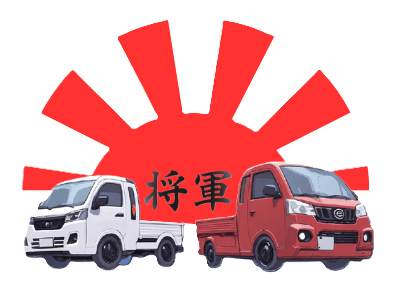The Daihatsu Hijet Review & Specs
The Daihatsu Hijet is a compact van and truck that has been delighting drivers since 1960, created by the innovative Japanese company Daihatsu. Originally featuring a 360 cc two-stroke engine to meet Japan's kei car regulations, the Hijet's engine size increased to 550 cc in 1976 and then to 660 cc in 1990. By 1980, Daihatsu proudly marked the production of two million Hijets, solidifying its legacy of reliability.

First-Gen Daihatsu Hijet 1960-1966
The Daihatsu Hijet debuted in November 1960, followed by a closed van version in May 1961. It featured a pickup truck design with the engine in front and the driver behind it. Its 356 cc engine produced 17 horsepower, allowing a top speed of about 75 km/h (47 mph). In 1964, the Hijet received a chrome grille. A more powerful version called the New-Line was introduced in January 1963, measuring 20 inches longer and capable of carrying 500 kg (1,102 lbs) with its 800 cc engine that produced 41 horsepower. This version was aimed at export markets but didn't meet kei car regulations, leading to limited production. The first generation of Hijet ended in February 1966, leaving a notable legacy in automotive history!
- 356cc 17 HP- 800cc 41 hp
- Front-Engine RWD
- 3-Speed Manual
- Height:: 63.6 Inches
- Length: 117.9 Inches
- Width: 51 Inches

Second-Gen Daihatsu Hijet 1964-1968
In 1964, the truck design optimized cargo space. Customers could choose between the classic and the new version. The "New Line Cab" Daihatsu truck, including the S50 and S50T models, which replaced the older L50 model. Produced from February 1966 to March 1968. The design was influenced by earlier vehicles like the Volkswagen Type 2 (1950), the Ford Econoline, and the Chevrolet Greenbrier (1961), paving the way for an exciting future in trucking.
- 356 cc ZM two-stroke I2
- Mid-Engine RWD
- 3-Speed Manual
- Height:: 64 Inches
- Length: 117.9 Inches
- Width: 51 Inches

Third-Gen Daihatsu Hijet 1968-1972
The design has evolved to a sleek, rectangular shape. The front doors now open in a contemporary style, moving away from traditional hinges. Powered by the ZM I engine, both the truck and van versions of the Hijet reach a top speed of 85 km/h (53 mph). Notably, an all-electric option was available.
- 356cc ZM two-stroke I2, 23 hp
- Mid-Engine RWD
- 4-Speed Manual
- Height:: 62-64 Inches
- Length: 118 Inches
- Width: 51 Inches

Forth-Gen Daihatsu Hijet 1971-1981
In September 1971, the fourth generation of the Daihatsu Hijet was launched with a new design and a 360 cc ZM two-stroke engine. By February 1972, the "Slide Van" was introduced, featuring a practical top-opening tailgate. An update in September 1974 allowed for larger license plates.

The Hijet 550 debuted in October 1976 with a 550 cc engine and a lengthened body for larger bumpers, catering to new kei car regulations. Export versions delivered 29 HP with a payload of 300 kg to 350 kg. The Hijet Wide 55 followed less than a year later, and in April 1979, the Hijet 550 received a facelift with a new black grille. Production of the four-stroke model ended in April 1981, while the two-stroke continued until August 1981.
- 550cc 29.5 hp
- Mid-Engine RWD
- 4-Speed Manual
- Height:: 64 Inches
- Length: 118 -122 Inches
- Width: 51 Inches

Fifth-Gen Daihatsu Hijet 1977-1981
In April 1977, the fifth generation Hijet, the "Hijet Wide 55," was launched, featuring a wider design and a 547cc two-cylinder engine with 29 HP for export models). It had a four-speed manual transmission and a top speed of 105 km/h (65 mph).

The engine was under the front seats, with models identified by codes: ‘S60’ (base), ‘P’ (pickup), ‘T,’ and ‘V’ (van). The van has sliding doors; a panel van version was introduced in June 1977. By December, a low-floor dropside bed was added, and in September 1978, updates included new bumpers and a more prominent grille logo. Customers could choose between Standard or Super DeLuxe trims, with a “Custom EX” version debuting in March 1979. The Hijet received a front design makeover in September 1979 and continued production until the sixth generation took over in 1981.
- 550cc 29.5 hp
- Mid-Engine RWD
- 4-Speed Manual
- Height:: 64 Inches
- Length: 126 Inches
- Width: 55 Inches

Sixth-Gen Daihatsu Hijet 1981-1986
In March 1981, the updated Daihatsu Hijet was launched, featuring a longer wheelbase and the reliable AB20 engine with 28 horsepower. Options included a flat floor for vans and a high roof. The S66 was introduced in March 1982, with a four-wheel drive option added in 1983. The Hijet could carry up to 772 pounds in Japan and 1,246 pounds in export versions.

A one-liter version producing 47 horsepower was launched in 1983, and by 1985, a four-wheel drive option for the Hijet 1000 was available. The Hijet Jumbo was introduced in 1983, and the Hijet Atrai Van debuted in September 1981 for added comfort. The S65V design had a turbocharged version that arrived in February 1984.
- 550cc 29.5 hp
- Mid-Engine RWD
- 4-Speed Manual
- Height:: 65-72 Inches
- Length: 126-133 Inches
- Width: 55 Inches

Seventh-Gen Daihatsu Hijet 1986-1994
The seventh generation of the Daihatsu Hijet debuted in May 1986 with the S80 and S81 models, featuring a three-cylinder EB engine under 550 cc for efficiency. In the U.S., the Hijet targeted commercial drivers, while Japan saw the "Jumbo Cab" and "Deck Van." Export models often had a 993 cc engine, while Japanese models stayed at 550 cc until regulatory changes in the early ’90s allowed for the larger S82 and S83 models.

A supercharged version arrived in 1987, followed by a 660 cc engine in 1990 and a turbo engine in the passenger Atrai. In September 1992 introduced new designs and engine options. Meanwhile, the Daihatsu Zebra was launched in Indonesia in 1986 with a 1.0-liter engine, which was upgraded to 1.3 liters by 1989.
- 550cc 43 hp
- Supercharger, 71HP
- Mid-Engine RWD & 4WD
- 4-5-Speed MT & 3-Speed Auto
- Height:: 72 Inches
- Length: 126-130 Inches
- Width: 55 Inches

Eighth-Gen Daihatsu Hijet 1994-1999
The eighth generation of the Hijet was launched in January 1994, after debuting at the 30th Tokyo Motor Show in October 1993. This generation included two-wheel and four-wheel drive models, identified by specific codes: "P" for trucks, "C" for panel vans, and "V" for glazed vans. The Hijet EV, a fully electric version, was introduced in May 1994. Automatic models had a fuel-injected engine producing 43 HP, while manual versions had slightly less power. 1995, the Hijet EV Truck and van were added, and in October 1997, the sporty "Hijet IS" was added. The updated Atrai came with a turbocharged engine, while sportier models like the Turbo SR and RT featured anti-lock brakes. The Atrai Classic launched in October 1997 with luxury features, including a leather interior and keyless entry.
- 660cc 43 hp
- Mid-Engine RWD & 4WD
- 5-Speed MT & 3-Speed Auto
- Height:: 74.8 Inches
- Length: 129.7 Inches
- Width: 54.9 Inches

Ninth-Gen Daihatsu Hijet 1999-2007
The ninth generation Hijet was launched in 1999, featuring the Hijet Cargo van with a forward-engine design by Italdesign Giugiaro and the Hijet Truck with a middle-mounted engine designed by Daihatsu. 2004 the tenth-generation Hijet Cargo replaced earlier models, while the ninth-generation truck continued until July 2014. Both adapted to new safety regulations. In December 2007, interior features and fuel efficiency improved by 10%. By December 2010, it became the top-selling kei truck, surpassing the Suzuki Carry for the first time in 39 years. The seven-seat Daihatsu Atrai 7 and the larger commercial Daihatsu Hijet Gran Cargo debuted in July 2000.
- 660cc 43 hp
- Mid-Engine RWD & 4WD
- 5-Speed MT & 3-Speed Auto
- Height:: 74.8 Inches
- Length: 129.7 Inches
- Width: 54.9 Inches
- Weight: Truck-2,006-Ib Van-2,227-Ib

Tenth-Gen Daihatsu Hijet 2004-2024
In December 2004, the Hijet had its original design until a new generation debuted in September 2014. Since then, the van and truck have evolved into separate models sharing engines. In Japan, the passenger version is called the Daihatsu Atrai, equipped with a 660 cc turbocharged engine producing around 64 horsepower. From 2004 to late 2007, options included 53 and 45-horsepower engines. By December 2007, it had updated engine identifiers and introduced a more efficient option. A hybrid version of the Hijet Cargo was phased out in April 2010 due to cost issues. In April 2015, the Cargo model received a new four-speed automatic transmission. The Hijet and Atrai were redesigned in November 2017 with a new front end.
- 660cc 53 hp
- Mid-Engine RWD & 4WD
- 5-Speed MT & 3-4 Speed Auto
- Height:: 70-74.2 Inches
- Length: 133.7 Inches
- Width: 58.7 Inches
- Weight: 1,631–1,874 lb


